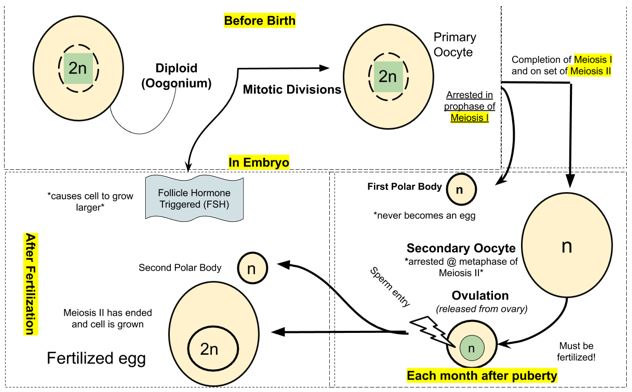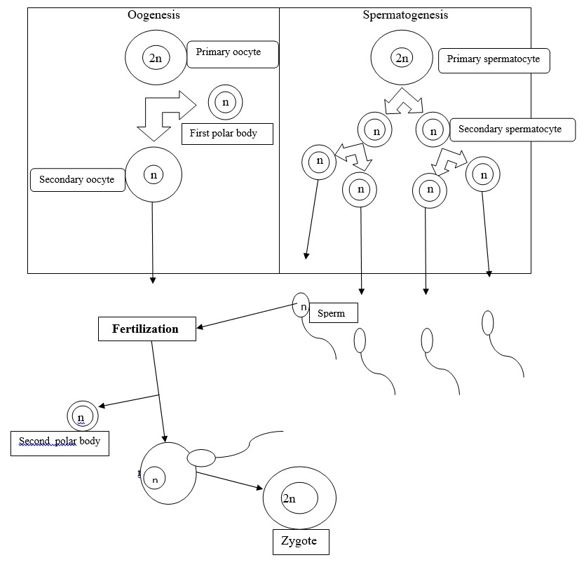Gametogenesis the cycle in which cells of the female and male germs are produced. The sustenance of any animal depends on its reproductive ability. Although some organisms reproduce by asexual reproduction, humans and other mammals rely on sexual reproduction for the spread of their species. To facilitate this process, specialized sex cells are produced for the transmission of their genetic code from parents to their offspring. Gametogenesis for sperm formation is known as spermatogenesis while that of ova is known as oogenesis.
In Spermatogenesis spermatozoa develops in the seminiferous tubules of the testis from germ cells. Spermatogenesis is a complex process involving division of mitotic cells, and it starts at puberty and continues for the rest of a male’s life. Both gametes are haploid cells that carry 23 unpaired chromosomes, half the human genetic makeup. Oogenesis is the process by which female (ova) gametes are formed. The meiosis process in human female gametes is distinct from the meiosis process in male gametes, by which four haploid gametes are formed from a single diploid cell. Cell division is one of the important functions of the nucleus.
Also, unlike the male gametes continually produced from puberty onwards, female gametes production occurs entirely before birth with maturation occurring after puberty in pulsatile fashion.
What you need to know regarding Oogenesis?
Oogenesis is the formation of female embryos. Occurs within the ovary in females. Oogonia develops from the germinal epithelium which surrounds the ovary. A cycle that is discontinuous, and completed in a few days to years. In the ovaries, the first division of maturation is completed but the second one is completed outside ovaries after fertilization begins. An oocyte is just one ovum or one egg that you can see through naked eyes. However, student microscopes are accessible to observe these cells in detail. A primary oocyte divides by meiosis I into one secondary oocyte divide and one polar body. Ootids as such participate in reproductive activity.
Secondary oocyte divides an ovum and a polar body by meiosis II. Ovum has many food reserves and other biochemical. Eggs are bigger than oocytes. Nucleus remains in the ovum as uncondensed. Usually there is no such differentiation present. One oogenia alone produces oocytes. The process creates female gametes which are non-motile. The period of development is protracted.
What you need to know regarding Spermatogenesis?
Spermatogenesis is sperm formation. Happens inside the testis in males. Spermatogonia develops from the lining of germinal epithelium, the seminiferous tubules. A continuous process and finished in about 74 days. In tests both maturation divisions are completed. Four spermatozoa contain a spermatocyte. A primary spermatocyte form two secondary spermatocytes by Meiosis I. To participate in reproduction, the spermatids must be transformed by the spermiogenesis process into threads like sperm.
Secondary spermatozoa splits into two spermatids by meiosis II. Reserve food in the sperms is small. Sperm is smaller than spermatozoa. Nucleus is condensed to the sperm. Many of the germ epithelium cells also act as protection called sertoli cells. Each of the spermatogonia differentiate into spermatozoa. Motile male gametes are produced in the process. The period of growth is shorter.
Oogenesis VS Spermatogenesis
When the primary Oocyte eventually completes its first meiotic division, it uniformly separates the chromosomes but does not separate the cytoplasm equally. Nearly all the cytoplasm stays in one of the two daughter cells, which transforms into a secondary oocyte. The other daughter cell which gets half of the chromosomes in the cytoplasm but very little is called a polar body. Not being a working oocyte the polar body ultimately degenerates and dies. Polar body formation helps the primary oocyte to split its genome by half and retain much of its cytoplasm in the secondary oocyte.
Only after fertilization will the secondary oocyte complete meiosis II, giving off a third polar body once meiosis II has been completed and an egg fertilized. The oocyte degenerates 24 hours after ovulation, within the ovary, if fertilization never happens, remaining stuck in meiosis II. However, if the egg is fertilized the fallopian tube’s peristaltic movements transfer the egg to the uterus where it will insert into the posterior wall of the uterus.
The secondary oocyte which still has two copies of each chromosome finally becomes an ovum. To fully mature, the sperm cells undergo a number of structural changes and division. Next, two haploid cells develop from one diploid cell at meiosis 1. Sister chromatids then split during Meiosis II to produce four daughter cells. Through this process, each daughter cell receives a unique male gene combination which ensures genetic diversity. The cell starts as a spermatogonium (undeveloped diploid cell and ends as four spermatids. These spermatids make up the completely formed semen cell.
Spermatogenesis takes approximately 70 days so multiple spermatogenic processes occur concurrently within the same seminiferous tubule with new groups of spermatogonia occurring every 16 days (spermatogenic cycle) to ensure constant and not sporadic sperm production. That of those spermatogenic cell populations would be at various spermatogenesis levels. Remember that once sperm exits the male body and reaches the female reproductive tract the conditions there cause the sperm to undergo capacitation, which is removing cholesterol and glycoproteins from the sperm cell’s head to enable it to attach to the egg cell’s zone pellucida.
The following figure presents the process of oogenesis and spermatogenesis
Differences among oogenesis and spermatogenesis
| Comparative Basis | Oogenesis | Spermatogenesis |
| 1. Description | Oogenesis is the forming of female eggs | Spermatogenesis is sperm formation (masculine gametes) |
| 2. Production | Oogonia develops from the germinal epithelium which surrounds the ovary | Spermatogonia emerges from seminiferous tubules, the germinal epithelial lining |
| 3. Gametes | A single oocyte forms an egg or an ovum | Four spermatozoa contain a spermatocyte |
| 4. Food reserve | Ovum has plenty of food in reserve and other biochemical | Reserve Food in the sperms is little |
| 5. Division product | One oogenia alone produces oocytes. | All spermatogonia break up to form spermatozoa. |
| 6. Cell differentiation | Such distinction is typically not present | Many of the germinal epithelium cells act as help, also called sertoli cells |
| 7. Nucleus | Nucleus remains in the ovum, uncondensed. | nucleus in the sperm undergoes condensation. |
| 8.Meiosis II products | Secondary oocyte divides into one ovum and one polar body by meiosis II | Secondary spermatozoa separates into two spermatides by meiosis II |
| 9. Reproduction | Ootids as such engage in the reproduction cycle | The spermatids have to turn through the cycle of spermiogenesis into threads like sperm to engage in reproduction |
| 10. Size | Eggs are greater in size than oocytes | Sperm is smaller than spermatozoa |


